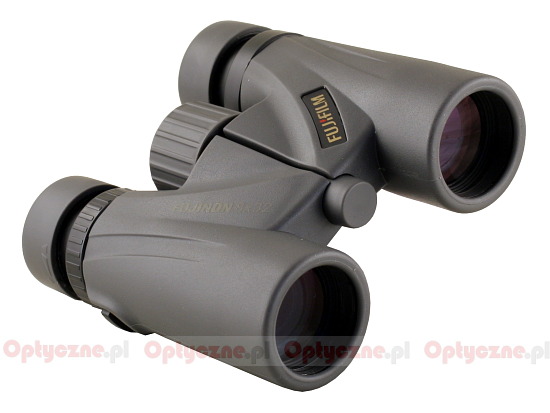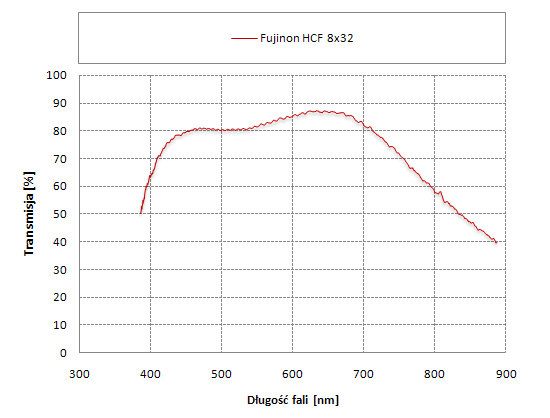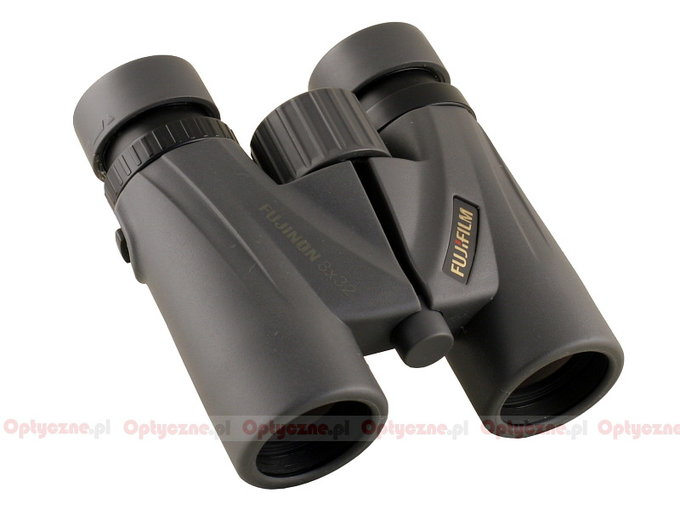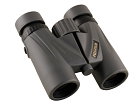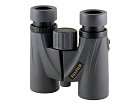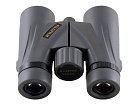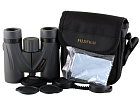In March 2008 during the IWA 2008 in Nürnberg, a hunting and sporting equipment exhibition, the Fujinon company announced the launch of 7 new roof-prism sets of binoculars. The new series was marked with HCF letters and was supposed to be comfortable in usage with an attractive price/quality ratio. You can choose from models with the following parameters: 8×25, 10×25, 8×32, 10×32, 8×42, 10×42, 10×50.
Fujinon accustomed us to the highest optical quality products, made in Japan. It’s enough to mention excellent results, reached by FMTR-SX models in our tests and an HP series, which has been highly praised. They’ve moved a part of the production unit to China and launched cheap roof-prism devices on the market, with Schmidt-Pechan roof prisms covered by aluminum, though. Is it a good strategy? Will the company gain or lose? We hope our test will answer this questions.
If you buy an HCF series set of binoculars you get objective lenses covers, a rainguard, a strap, a case with another strap, and a cleaning cloth included in the box. The device is waterproof and nitrogen-filled and it comes with a 5-year-long guarantee.
Distribution / Sales:
AstroClassic
web site
| Magnification |
Lens diameter |
Angular field of view |
Prisms |
Eye relief |
Weight |
Price |
| 8 |
32 |
114/1000(6.5o) |
BaK-4/roof |
18 mm |
370 g |
499 PLN |
|
|
| Real front lens diameter |
Left: 31.6+/-
0.05 mm
Right: 31.6+/-
0.05 mm
|
6 / 8.0 pkt |
| Real magnification |
8.4+/-
0.07x
|
2.5/3.0 |
| Transmission |
80.6+/-
1%
|
10/25.0 |
| Chromatic aberration |
Visible in the centre, medium at the edge.
|
4.7/10.0 |
| Astigmatism |
Medium at most.
|
4.5/10.0 |
| Distortion |
The distance of the first curved line from the filed centre compared to the field of view radius: 34% +/- 3%
|
3/10.0 |
| Coma |
Quite well corrected. It appears in 60-70% of the field and is medium at the edge.
|
6.3/10.0 |
| Blurring at the edge of the FOV |
The blur occurs in the distance of 86% +/- 3% from the field of vision centre.
|
7/10.0 |
| Darkening at the edge the FOV |
Noticeable.
|
3.7/5.0 |
| Whiteness of the image |
Gray pink. Transmission significantly higher in the red part of the spectrum.
|
2.9/5.0 |
| Collimation |
Exemplary.
|
5/5.0 |
| Internal reflections |
| Left: |
Right:
|
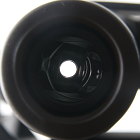 |
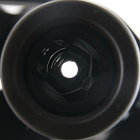 |
Visible. Average work against bright light.
|
2.5/5.0 |
| Housing |
Small, short, very handy. Plastic twist-up eyecups. One of them moves very easy and can be collapsed when you press it against the face. The rubber sticks out near objective lenses. A bit of grease near the screw and on the ocular bridge.
|
4.2/8.0 |
| Focusing |
Big and comfortable central screw, which moves smoothly (full turn takes as many as 700 degrees!). Individual focusing on the right eyepiece – it clicks quite loudly and moves the lens.
|
4/5.0 |
| Tripod |
No exit. In the 8x32 test all pairs of binoculars were granted an average value of 1.5 points in this category as a tripod exit in this class of equipment is rarely used.
|
1.5/3.0 |
| Interpupilary distance |
from 56.8 to 74.9mm
|
5/6.0 |
| Closest focusing distance |
1.0 m. |
2/2.0 |
| Eyepieces FOV |
Apparent field of view of 54.0 deg (according to simple formula) and 50.5 deg (according to tangent formula). |
6/20.0 |
| Field of view |
Measured by us amounted to 6.43 +/- 0.03 degrees and it was a bit narrower than that in the specifications. Small field of view for this class of parameters.
|
5/8.0 |
| Quality of the interior of the barrels |
Inner tubes are black but slightly shiny. Grey bottom. Some specks of dust and significant stains (damp patches) on the left prism.
|
2.6/5.0 |
| Vignetting |
| Left: |
Right:
|
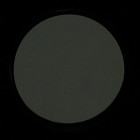 |
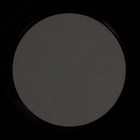 |
Slightly egg-shaped pupils.
OL: 0.7%, OP: 1.4% |
6.5/8.0 |
| Prisms quality |
Good quality BaK-4.
|
8/8.0 |
| Antireflection coatings |
Green on objective lenses and prisms. Green-yellow on eyepieces. High intensity.
|
4/5.0 |
| Warranty [years] |
5 |
3.5/6.0 |
| Final result |
58.1%
|
110.4 / 190 pkt
|
| Econo result |
|
0pkt. |
Summary
Pros:
- small and handy,
- one of the lightest 32 mm class sets of binoculars,
- sharp image in almost all field of view,
- minimum focus already from 1 meter,
- good quality BaK-4 prisms.
Cons:
- narrow field of view,
- high distortion,
- slightly egg-shaped exit pupils,
- not very solid eyecups.
What can be said here? This Fuji product didn’t turn out well – first of all its given and real parameters don’t match. Objective lenses are smaller than should be, the magnification – bigger. The field of view, although one of the narrowest in this equipment class anyway, is still a tad smaller than given in the specifications. During our test one eyecup got loose and we were able to collapse it applying even the lightest pressure. Inside the inner tubes we saw dirt and stains. If you want to save money moving the production to China you might experience serious side effects…
The coatings are quite intensive and it doesn’t bode well for transmission results especially if the light falls at higher angles. The graph of radiation falling along the optical axis is presented below. The results are hardly sensational but it would be difficult to expect them to be so if only on the prisms we lose over 10% of light because of the aluminum reflective surface…
If you compare the Fujinon’s 8x32 pros and cons lists, its price and also the prices of its most serious rivals you might come to a conclusion that such a purchase is perhaps not the best choice possible.
